Didyma sailing holidays
The archaeological site of Didyma, once the greatest Greek oracular sanctuary in Asia Minor, with the ruins of a mighty Temple of Apollo, is situated on the Miletus Peninsula 2 NM inland from the Aegean Turkish coast.
Didyma is linked with Miletus by a Sacred Road, still partly traceable, which according to an inscription on the last milestone was built in 101 CE in the reign of Trajan. Over 16 Kilometres long and 5 – 7 metres wide it ran past the ancient pilgrim post of Panormos (now Kovala Burun) to the sanctuary. The last section, which has been excavated, was lined with Archaic seated figures and recumbent lions (remains in the British Museum) and with later tombs.
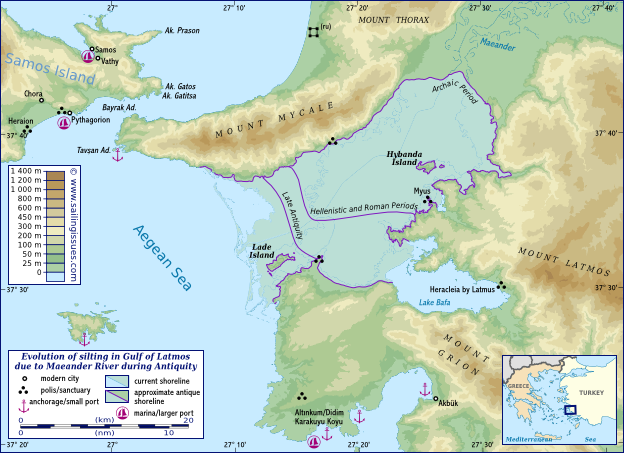
|
Didyma
Miletus
Priene
|
Within the area of the site is the village of Yeni Hisar (New Castle), which was partly abandoned after the Greek withdrawal in 1923. The remaining inhabitants were later moved to Alkınkum (Golden sand) in order to leave the site clear for large-scale excavation.
Myth and history
Even before the coming of the Greeks and the foundation of Miletus, there was a Carian oracular shrine here under the name of Didyma. The Ionians who settled in this area in the 10th century BCE dedicated the shrine to Apollo Philesios, and thereafter the oracle enjoyed great prestige, even rivalling Delphi. The last King of Lydia, Kroisos (Croesus), consulted it and made rich offerings to the shrine, as did the Egyptian Pharaoh Necho.
The original sanctuary was destroyed in 494 BCE by Darius' Persians after members of the local priestly family, the Branchids, had surrendered the cult image and the temple treasure to the Persians. Only a few fragments of masonry from the first temple have been found.
After Alexander the Great's victory over the Persians the temple – the Didymaion – was rebuilt on a considerably larger scale. It was begun about 300 BCE by Paoinios of Ephesus and Daphnes of Miletus after the completion of the Temple of Artemis in Ephesus. The new temple was planned on such a grandiose scale, however, that in spite of financial support from the Roman emperors and other sources it was never finished. By 280 BCE the shell of the building was completed, but Strabo tells us that because of its size it was never roofed.
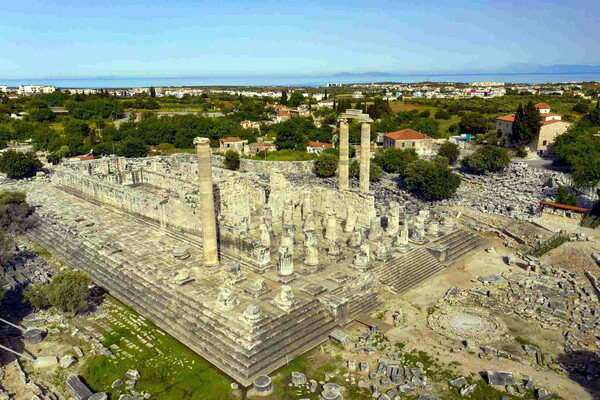
In gramercy for a favourable oracular pronouncement in 312 BCE Seleukos I Nikator caused the statue of Apollon, which had been stolen and carried off to Persia, to be returned to the temple.
In the Early Byzantine period the temple, still perfectly preserved, was converted into a Christian basilica, with a holy well. Later, after the building had suffered severe damage in a fire, a fortress was constructed in the ruins. The destruction of the temple was completed by another fire and a severe earthquake in 1446. During the 15th century it was used to provide makeshift accommodations for harvest workers from Samos.
The excavation of the site was begun by British archaeologists in 1858 and continued on a larger scale by French expeditions in 1872 and 1895 – 96. Further work has been done by German archaeologists since 1962.
Temple of Apollo (Didymaion)
The huge Temple of Apollo or Didymaion (well excavated and partly restored), was oriented from north-east to south-west and was originally surrounded by a sacred grove. At the north-east end was a semicircular terrace (partly built up) dating from the Archaic period, on which were a portico, other buildings and various votive gifts. Four flights of steps 2½ metres wide led down to the cella of the temple.
Outside the northeast end of the temple is the main altar, which was similar to the one at Olympia in the Peloponnese.
Within a low parapet was a conical structure built up from ashes mixed with the blood of sacrificial animals. To the north of the altar a bases for votive statues and a well of the Hellenistic period.
Along the southeast side of the temple, 15 metres away were seven tiers of seating for spectators at the games that were held here.
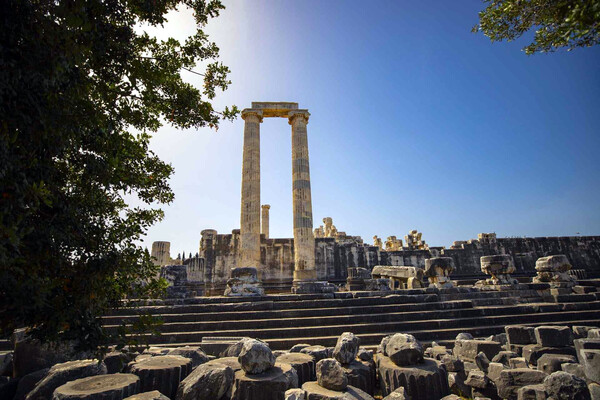
The temple itself was 108½ metres long by almost 50 metres across. It stood on a seven stepped base, with five additional steps at the north-east end, the main front. It was of the type technically known as “dipteral decastyle”, surrounded by a double row of columns, with 10 at each end and 21 along the sides. Three of the columns at the ends, 19.4 metres high, are still standing. The unusual base, dating from the time of Caligula (37 – 41 BCE), are in similar pairs. The corner columns on the east front had figural capitals each with two bulls' heads, a bust of a god and a griffin. The frieze had an alternation of foliage ornament and Medusa heads.
Pronaos
The temple consisted of a pronaos or forecourt, a small antechamber and the cella or main chamber. In the pronaos, the walls of which still stand 11 metres high, were four rows of three columns. Including the double row of columns of the portico, therefore, the entrance to the temple had four rows of five columns.
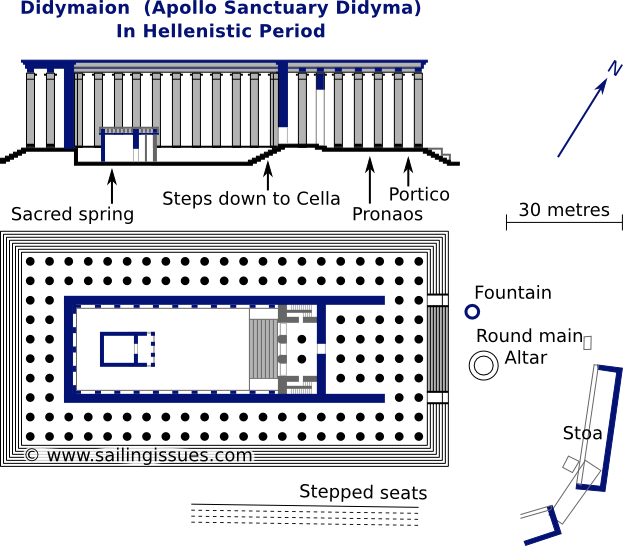
From the pronaos, which had a magnificent coffered ceiling, the cella was reached either through two small doors flanking the main doorway and then down two vaulted tunnels, or through the main doorway (8 metres wide) and a small antechamber on a slightly higher level. This antechamber was the chresmographeion, in which the priests revealed and interpreted the pronouncements of the oracle. The ceiling of this room was borne on two Ionic columns (making the total number of columns in the temple 122).
Cella
From the antechamber three doors opened on to a flight of steps 16 metres wide leading into the cella 5½ metres lower down, which was roofless.Round the walls were pilasters with griffin capitals; originally of the same height as the columns on the outside of the temple; the pilasters have been re-erected to a height of 6 metres.
In the cella were the sacred spring, at which the priestess put questions to the oracle, and a sacred olive tree. On the end wall, in a special room, was the cult statue of Apollo.
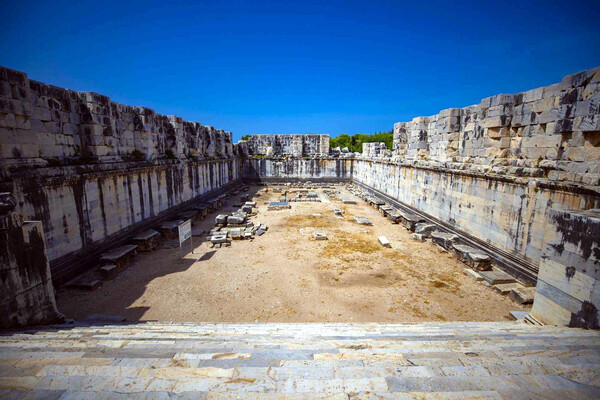
From the site there are magnificent views, extending northward to Karakuyu Bay, in which lay the Milesian port of Teichioussa, eastwards to the hills of Caria and southward to the Bodrum Peninsula and the Greek island of Kos.
Sailing holidays & yacht charters
The ideal way to visit the splendid archaeological sites like Didyma is via sailing holidays and blue cruises – Gulet motor sailers out of the yacht charter bases of:
From these larger ports it is just a short sailing distance to the established Didim Marina – see image below – from where it is a short trip (scooter, taxi or hired car) to the archaeological sites in the area.
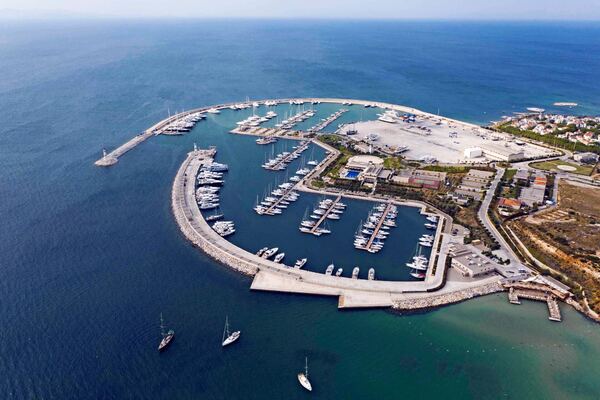
Yet, the adjacent port of Alkınkum is perhaps less sheltered but a more picturesque spot to visit Miletus, Priene and Didyma from. Plus there is an excellent Turkish bath.